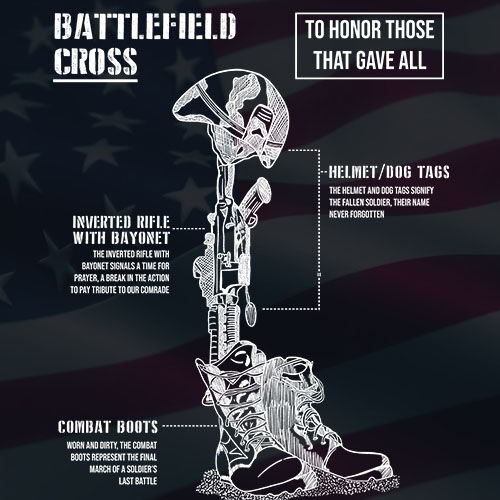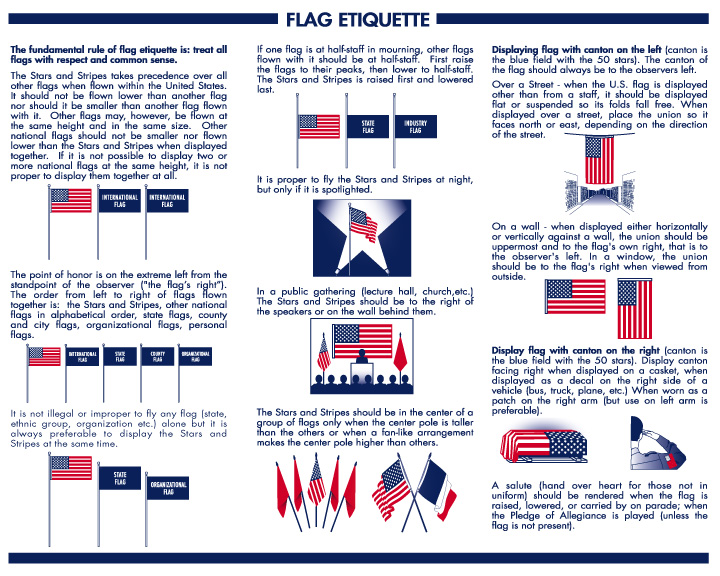

During the Korean War, changes were made to the process of handling the dead; instead of interring the soldiers in temporary military cemeteries, they were removed to staging sites to be readied for shipment to Japan and ultimately home. The battlefield cross memorial probably took on more significance during this time, as a way to provide closure for the fallen soldier's comrades. Richard Holmes put it best in his book, Acts of War: The Behavior of Men in Battle: "Proper burial of the dead, accompanied by a degree of formalized mourning, is as necessary for those who die in battle as it is for those who perish in more peaceful circumstances. Having some sort of focus for mourning is useful for the dead soldier's comrades."

When troops hastily buried fallen soldiers between battles, the soldier’s rifle with a bayonet was stabbed into the ground as a marker to identify the eternal resting place of a soldier’s remains or to mark the location of the soldier’s remains for later removal. Belongings were placed on the rifle so others would know who rested there. Decades later, the configuration of a gun pointed downward with a helmet perched on the stock was a more common sight during WWI and WWII.
Today, the Soldier’s Cross serves as a symbol and stands as a visible memory of a fallen soldier. The contemporary Soldier’s Cross consists of:
The Rifle
which is key to a
service member’s survival. The bayonet is
thrust into the ground signifying that the
one who died perished in battle and paid
the ultimate sacrifice. It also conveys that
the fight is over for this service member.
The boots
carry a service member through
combat and are the most important means
of transportation.
The boots, worn and
dirty, are placed at the base of the rifle
and represent this soldier’s final march.
Dog tags
have imprinted upon them the
identifying information unique to each
service member and are worn by all who
serve irrespective of rank.
The dog tags hang from the rifle in the Soldier’s Cross
symbolizing that this individual should
never be forgotten.
The helmet
, never to
be worn again, is placed on the butt of the
rifle indicative of the great sacrifice that has
occurred.
This symbolic replacement of a cross or marker serves as a means of showing respect for the fallen amongst the living members of the troops. Many unit commanders have recognized the value of a memorial and encourage their people to pay their respects for their fallen brothers and sisters in arms at ceremonies typically conducted on base or at the site of the battle where traditional funerals are not possible. Chaplains will use the Soldier’s Cross as a visible representation in honor of one who has perished as the congregation celebrates the life of a fallen soldier. Liberty’s flame, the Soldier’s Cross internal to Liberty’s torch, combined with the nighttime glow emanating from The Flame of Liberty Memorial, will portray the message that freedom is not free, it comes at a price and that the sacrifices of a few deliver the liberty enjoyed by many.
Read more.

The Fourth of July—also known as Independence Day or July 4th—has been a federal holiday in the United States since 1941, but the tradition of Independence Day celebrations goes back to the 18th century and the American Revolution. On July 2nd, 1776, the Continental Congress voted in favor of independence, and two days later delegates from the 13 colonies adopted the Declaration of Independence, a historic document drafted by Thomas Jefferson. From 1776 to the present day, July 4th has been celebrated as the birth of American independence, with festivities ranging from fireworks, parades and concerts to more casual family gatherings and barbecues.

July is named after Roman dictator Julius Caesar (100 B.C.–44 B.C.). Caesar developed the precursor to the Gregorian calendar we use today. Find out the origin of each month’s name.
July’s full Moon, the Full Buck Moon, occurs on Monday, July 3. It reaches peak illumination at 7:39 A.M. (EDT), rising above the horizon after sunrise—but it will still be spectacular in the night sky. Plus, it’s the biggest and brightest supermoon of the year. Find out why it’s called the Buck Moon!

I hear America singing, the varied carols I hear,
Those of mechanics, each one singing his as it should be blithe and strong,
The carpenter singing his as he measures his plank or beam,
The mason singing his as he makes ready for work, or leaves off work,
The boatman singing what belongs to him in his boat, the deckhand singing on the steamboat deck,
The shoemaker singing as he sits on his bench, the hatter singing as he stands,
The wood-cutter’s song, the ploughboy’s on his way in the morning, or at noon intermission or at sundown,
The delicious singing of the mother, or of the young wife at work, or of the girl sewing or washing,
Each singing what belongs to him or her and to none else,
The day what belongs to the day—at night the party of young fellows, robust, friendly,
Singing with open mouths their strong melodious songs.
Through loud crashes
And heroic smashes
Through long nights and lonely walks
July you stayed by my side.
July, you were there
When few could claim thus.
You showered your care
When others made hardly a fuss.
July, you were there
When the bottom fell out
July so fair, so constant
When all I could do was shout
July,
You were my first days without her
My first lonely nights,
my misery, my muse,
my history, my news
July I don't know why you came to me
Or how I ended up with you at my side.
But now that time has past, and those wounds have scared and healed
I'm ready to return to you and say that Im grateful for you, and for those really hard nights.
They taught me the brevity of life.
They taught me to hold on:
To those I love a little tighter,
To those I cherish a little deeper,
To stay up talking a little longer,
To drive a little farther,
To try a little harder,
To love a little richer
July July,
I cry to think
I cry to remember
I cry to retrace those summer steps
Those first days without her.
July July,
Thank you for being there
When I didn't understand
And I couldn't comprehend.
Though I didn't see it
You were what was best.

The U.S. Flag Code offers guidelines for flying the flag on July 4, and every day.
The rules for handling and displaying the U.S. Flag are defined by a law known as the U.S. Flag Code. We have excerpted the federal regulations here without any changes so you can find the facts here.
STANDARDS of RESPECT
The Flag Code, which formalizes and unifies the traditional ways in which we give respect to the flag, also contains specific instructions on how the flag is not to be used. They are:
